The Rockridge Math Department – Beyond the Numbers
April 25, 2024 - 8 minutes readThis special blog post was crafted by the Rockridge Math Department to help promote the thinking and learning in our MYP classrooms – The IB MYP shares the belief that mathematics should promote both inquiry and application, helping students to develop problem-solving techniques that transcend the discipline and that are useful in the world beyond school. The goal is to graduate students who are ready to contribute to a thriving economy and society.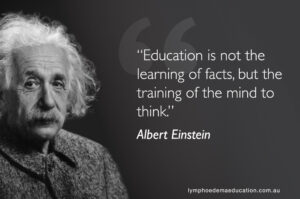
The British Columbia redesigned curriculum recognizes and respects the diverse cognitive processes, learning styles, and developmental stages of each student, and prepares them for a life where learning is ongoing, and change is constant. The mathematics curriculum, which closely aligns with the guidelines of the NCTM (National Council of Teachers of Mathematics), supports students in using math problems and tasks that foster reasoning and problem-solving. Rich thinking tasks engage students in solving and discussing problems that enhance mathematical reasoning and problem-solving skills, allowing multiple entry points and varied solution strategies.
As experienced and passionate math teachers, we believe that mathematics education plays an important role in preparing students to be successful in the modern world. Successful students don’t only need knowledge, they also need solid communication, critical thinking, and problem-solving skills. The ability to think critically and solve problems is essential for success in any field. Our role as math teachers is to not only help students develop tools to solve math problems but also to provide students with plenty of opportunities to challenge themselves with problems that require perseverance and creative thinking. Students need opportunities to figure out what the best tool for the job is and the richer the task, the more tools they will need to utilize.
The mathematics International Baccalaureate (IB) Middle Years Program (MYP) at Rockridge separates assessment into four criteria. Criterion A: knowing and understanding, Criterion B: Investigating Patterns, Criterion C: Communication, and Criterion D: Application to the Real World. Criterion A teaches mathematics knowledge and skills (filling the toolbox). A Rockridge mathematics education also gives students the opportunities to use those tools to solve problems by stressing the three other criteria.
Students in grades 8 and 9 have been studying visual pattern problems from the website www.visualpatterns.org. Each pattern requires students to create a formula that will calculate the number of shapes in any given figure. The following pattern (Pattern 5 from the website) shows the first three figures as well as tells students that the 43rd figure will have 3,787 circles.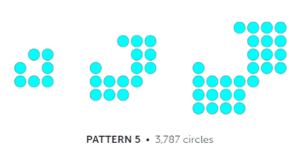
Students need to combine their algebraic skills with their problem-solving skills to find the number of circles in any given figure.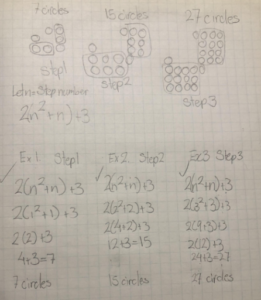
Grade 8 students have also studied Fruity Total problems from https://nrich.maths.org/fruity. In these problems, students must find the corresponding value of four different types of fruit: Apples, Bananas, Cherries, and Plums. The following is a solution from a grade 8 student. It is an excellent example of a student connecting the algebraic thinking developed in the classroom to problem-solving. As per the NCTM call to action for “multiple entry points and varied solution strategies,” there are several different ways to solve this problem and the student has communicated how they thought through the problem with an organized and logical structure.
The NCTM call for action also highlights the need for high-quality teaching that supports the learning of each and every student in equitable environments. One way this can be achieved in the MYP classroom is by finding low-floor, high-ceiling tasks. By leveling tasks, it is hoped that all students will have an opportunity to have some degree of success (low-floor) while differentiating questions gradually extend to non-familiar problems that challenge even the most capable students. In the next example, the thinking required is quite complex. 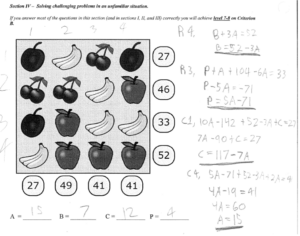
The following is a Criterion D task that was given to Math 10 students. In this question, students connect their understanding of Linear Relations and Rate of Change in a real-world context. Students are assessed on their ability to calculate the correct answer while communicating their understanding of the mathematics required to get their solution. We liken the importance of strong mathematical communication to a salesperson who may have a superior product (they can get the answer correct) but if they can’t convince us why we need it, who cares how good it is? The reader needs to buy what they are selling!
Grade 10 Criteria D example
Traditionally teachers primarily assessed mathematical ability by giving students a chance to answer one of each type of question from a unit and then gave them a mark based on the percentage of questions they could answer correctly. In a thinking-based classroom, that model now seems antiquated. Rockridge teachers applaud the implementation of a proficiency scale for middle school students that simply shows students whether they are currently working at an emerging (levels 1-2) developing (levels 3-4), proficient (levels 5-6), or extending level (levels 7-8). We supplement traditional knowledge-based tests with rich problem-solving tasks that focus on critical thinking and communication skills.
Parents often ask how they can support their students at home. One thing we can’t stress enough is that students need to have quiet homework time each evening. Students should sit in a visible area with no electronics completing the work posted on Google class. Parents can get their child’s Google password to help them make sure they have completed the assigned work. If problems can’t be solved please encourage them to put their hand up in class the next day to ask for help and follow up with them the next evening to spend more time practicing it.
The IB MYP shares the belief that mathematics should promote both inquiry and application, helping students to develop problem-solving techniques that transcend the discipline and that are useful in the world beyond school. The goal is to graduate students who are ready to contribute to a thriving economy and society.
GO RAVENS GO!
Tags: IB, math, mathematics, MYP, Rockridge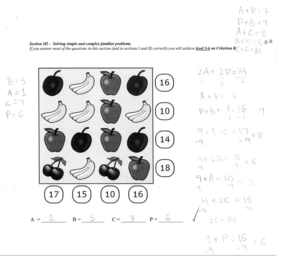
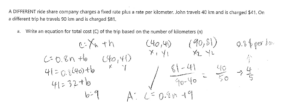
Recent Comments